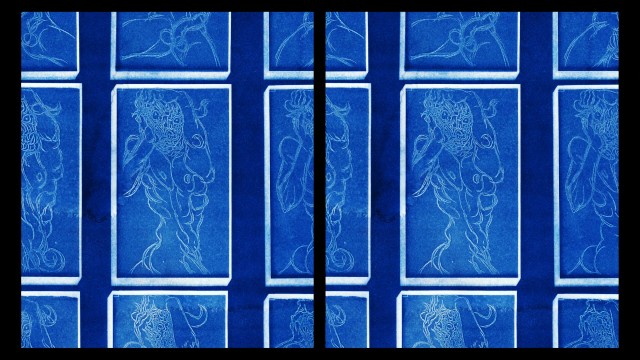Exasperated by an art world historically dominated by European white male artists, Chaerin Im’s Eyes and Horns serves as both a critique and a creative reaction to these frustrations. This 6-minute experimental animation channels Im’s emotions into a unique and captivating piece, where distinct craft and powerful themes converge to reimagine Picasso’s 1937 print series, the Vollard Suite.
A standout piece due to its unique aesthetic – combining lasercut-on-plexiglass with cyanotype photography – Im’s film explores themes of gender and representation in a singular fashion. Featuring mesmerising, cyclical animations, Eyes and Horns evokes a medley of emotions, with imagery that balances delicately between the beautiful and the unsettling.

“Each image was engraved into Plexiglas using a laser cutter. These 10 x 5 cm glass plates were then scanned to create the effect of light refracting through the engraved image, resulting in various visual effects caused by reflection and distortion.” – Im discussing her production.
“I made this film because I was tired of being an East Asian woman in a Western world”, Im reveals as she discusses the creation of Eyes and Horns with S/W. Expanding on this statement by ruminating on a “world that prioritizes Western values” and a lack of representation in art history, it’s evident that Im’s short film isn’t merely a reaction to a current trend but rather the culmination of long-held contemplations and frustrations.
“This film started with anger and frustration”
Describing the genesis of her film as one that “started with anger and frustration,” Im was deeply affected by her scrutiny of Picasso’s work, particularly his “audacious ignorance” and treatment of women. Reflecting on the “toxic masculine qualities” depicted in the Vollard Suite, her analysis ignited a spark, leading her to question: “If such thoughtless drawings are labeled as contemporary modern art, why should I doubt myself?”.
Through her critique of Picasso’s work, Im not only highlights its inherent patriarchal perspective but also takes a step toward reclaiming a space historically dominated by those aforementioned white male artists. Though only six minutes in length, Eyes and Horns explores complex ideas and demonstrates how modern artists can challenge their predecessors to create work that provokes new ways of thinking about all that has come before it.
While Im’s film may not be regarded in the same echelon as Picasso’s work, it undeniably stands as a powerful piece of art in its own right.

 Rob Munday
Rob Munday